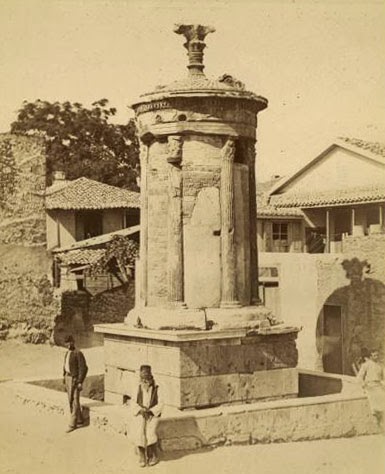 |
| The Lysicrates Monument in central Athens. |
Generals. Emperors. Gods and goddesses. Heroic deeds. Valiant efforts. Tragic endings. Those are the typical subjects for monuments in ancient Greece.
But not this monument. No, no, not this one. This monument comes with
jazz hands!
It is one of, perhaps
the, most-copied of all the ancient structures in the world. Erected in 334 B.C., the Lysicrates Monument commemorated the winning show choir at a drama festival. No joke.
At the time of construction, it was one of many such structures on a road
— Tripodon Street, i.e., the "Street of the Tripods"
— that stretched from Athens' theater of Dionysus at the base of the Acropolis to the center of town ("agora"). Each year, several wealthy choregoi were selected to sponsor the choruses for dramatic plays in theater competitions held at the Dionysian theater. With the choruses typically in training for months under the direction of heavyweight playwrights like Euripedes and Sophocles, a choregus was responsible for his troupe's room and board, costumes, props, scenery, and accompanying instrumentalists, among other expenses. If you know anything about Greek choruses, you know they not only chanted or intoned during the dramas, they also sang and danced. Obviously, it is the origin of our word "choreography."
The choregus of the winning troupe was expected to produce a feast and a parade, as well as to erect a monument. Atop the monuments were bronze tripods, which were the prize for winning the drama competition. Considered an honor and duty for influential Athenians, choregei included significant figures such as Pericles and Plato.
 |
| The Lysicrates Monument in The Antiquities of Athens. |
The Lysicrates Monument is the only surviving monument from the many that lined the street. The bronze tripod, which once sat upon the acanthus finial on top, is long gone. The frieze circling above the columns portrays the god Dionysus transforming pirates into dolphins, though it's partly eroded and somewhat obscured by pollution grime.
The monument was erected by "Lysicrates of Kykyna, son of Lysitheides," but he is not of any particular consequence. Instead, the monument owes its fame to its inclusion in a 1762 book called
The Antiquities of Athens and Other Monuments of Greece, by British authors James "Athenian" Stuart and Nicholas Revett. Their slightly idealized descriptions, and especially illustrations, of the Lysicrates Monument and many other ancient sites were influential and trendsitting for their type of architectural history and study. The book and its authors were major forces in a neoclassical architecture and Greek revival in Britain and the European continent.
With its grace and symmetry, as well as its Corinthian columns
— the oldest known Corinthian columns on the exterior of a structure — the monument provided an achievable model for architects from the eighteenth century to the modern day. Similar to how 16th century Italian architect Andrea Palladio frequently referenced the Greek temple style, with towering columns surmounted by a triangular pediment, the Lysicrates Monument became a touchstone for architects to insert as a cupola atop buildings or as a folly on the grounds of a country house. It was so popular as a neoclassical model that the new Driehaus Architecture Prize, which honors 21st century neoclassical architecture, issues a miniature Lysicrates Monument as a trophy.
Among the many structures which feature elements modeled upon or inspired by the Lysicrates Monument are the Dugald Stewart Monument atop Carlton Hill in Edinburgh, Scotland; the Tennessee State Capitol building in Nashville; the San Remo co-op building along Central Park in New York City; the Beacon folly in Staunton Country Park in England; the Old Well on the University of North Carolina campus; and the Lysicrates Monument reproduction in the Royal Botanic Garden in Sydney, Australia.
 |
| Dugald Stewart Monument |
|
 |
| Tennessee State Capitol |
|
 |
| San Remo co-op |
|
 |
| Beacon folly in Staunton Country Park |
|
 |
| Old Well at UNC-CH |
|
 |
| Royal Botanic Gardens in Sydney |
|
Despite its outsized influence on neoclassical architecture in our modern world, the monument sits amidst the bustle of Athens without much attention. Its information board is hidden behind the outdoor seating area for a restaurant across the street. Few passing tourists give it pause. Only the numerous street cats seem to appreciate the structure, mostly because of the perching birds eating in the garden.
 |
| Lysicrates Monument in excavation. |
|
 |
| Lysicrates Monument circa 1860. |
|
 |
| Lysicrates Monument in 1900. |
|
The Lysicrates Monument's 2,300+ years of history show the ebb and flow
that ancient monuments endure. As one of many such monuments on the
Street of the Tripods, it likely was unremarkable when built. Through
happenstance and luck, the monument survived while the others perished
over the succeeding centuries. At some point, its bronze tripod was
repurposed. In the 1600s, the monument was encircled by a French
monastery. It rose to fame in the late 18th century from inclusion in
The Antiquities of Athens,
and remained an inspiration for two centuries or more. In 1821, the
monument narrowly survived the fiery destruction of the monastery by the
Ottoman Turks. A few years later, it was unsuccessfully offered to
English buyers to move across the continent. And now, as the 21st
century progresses, the monument slowly subsides into anonymity.
 |
| The Lysicrates Monument rests in a small garden in the Plaka neighborhood of Athens. |









No comments:
Post a Comment